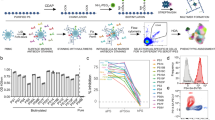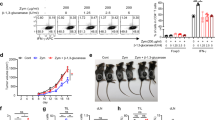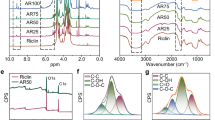Abstract
WE recently reported that saline extracts of smooth strains of Hæmophilus influenzæ (Type b) contain a substance adsorbable to erythrocytes1. Cells treated with such extracts are agglutinated by type-specific antisera. A sample of the type-specific polysaccharide, prepared by the method of Dingle and Fothergill2, absorbed from immune sera their power of agglutinating erythrocytes so sensitized, but was not itself capable of sensitizing them. We concluded, therefore, that the fraction in saline extracts which was adsorbed to erythrocytes was a combination of the type-specific polysaccharide with some other substance.
This is a preview of subscription content, access via your institution
Access options
Subscribe to this journal
Receive 51 print issues and online access
$199.00 per year
only $3.90 per issue
Buy this article
- Purchase on SpringerLink
- Instant access to full article PDF
Prices may be subject to local taxes which are calculated during checkout
Similar content being viewed by others
References
Keogh, North and Warburton, Nature, 160, 63 (1947).
Dingle and Fothergill, J. Immun., 37, 53 (1939).
Palmer and Gerlough, Science, 92, 155 (1940).
Morgan and Partridge, Biochem. J., 35, 1140 (1941).
Morgan, Biochem. J., 30, 909 (1936).
Author information
Authors and Affiliations
Rights and permissions
About this article
Cite this article
KEOGH, E., NORTH, E. & WARBURTON, M. Adsorption of Bacterial Polysaccharides to Erythrocytes. Nature 161, 687–688 (1948). https://doi.org/10.1038/161687b0
Issue Date:
DOI: https://doi.org/10.1038/161687b0
This article is cited by
-
Serological Characterization of Actinobacillus pleuropneumoniae Biotype 1 Strains Antigenically Related to both Serotypes 2 and 7
Acta Veterinaria Scandinavica (1996)
-
Serology of Haemophilus (Actino-Bacillus) Pleuropneumoniae Serotype 5 Strains: Establishment of Subtypes A and B
Acta Veterinaria Scandinavica (1986)
-
Serological Characterization of Haemophilus Pleuropneumoniae (Actinobacillus Pleuropneumoniae) Strains and Proposal of a New Serotype: Serotype 9
Acta Veterinaria Scandinavica (1985)
-
Serological Characterization of Haemophilus Pleuropneumonias (Actinobacillus Pleuropneumoniae) Strains and Proposal of a New Serotype: Serotype 10
Acta Veterinaria Scandinavica (1985)
-
Serological Characterization of 8 Haemophilus Pleuropneumoniae Strains and Proposal of a New Serotype: Serotype 8
Acta Veterinaria Scandinavica (1984)



